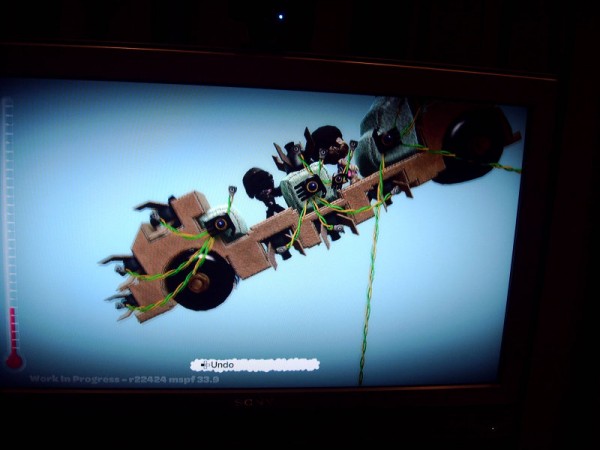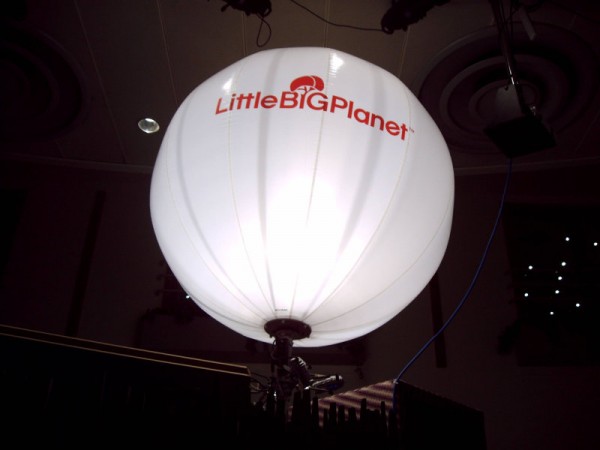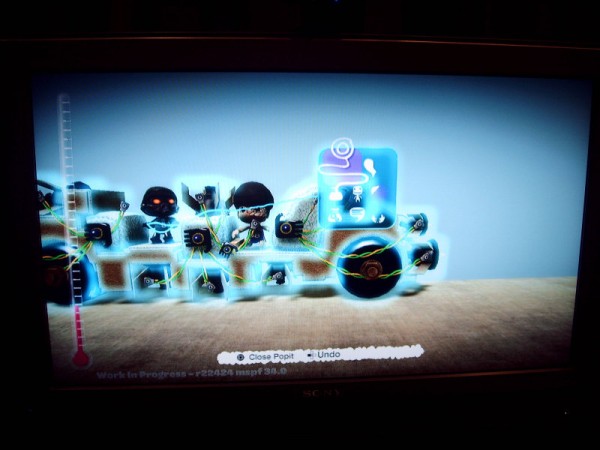LittleBigPlanet – Hands On PS3

The Edinburgh Interactive Festival earlier this week was the first chance for the British public to get their eager hands onto Media Molecule’s devastatingly adorable LittleBigPlanet.
Sackboy’s grinning mug has become something for the mascot for the Playstation 3, representing the almost childlike thirst for originality that was present in so many early PS2 games but has yet to have shown its face on Sony’s newest console.
Sony has clearly recognised this and has thrown its full marketing and PR weight behind this humble-yet-ambitious game that is being created right here in England, in the town of Guildford.
 When entering the Edinburgh International Conference Centre, the LittleBigPlanet stand was immediately and strikingly visible. The three PS3’s running copies of the game each had their own themed seating area based around different materials and textures found in the game, such as cardboard, cloth and grass. Irrelevant, but this was a nice touch.
When entering the Edinburgh International Conference Centre, the LittleBigPlanet stand was immediately and strikingly visible. The three PS3’s running copies of the game each had their own themed seating area based around different materials and textures found in the game, such as cardboard, cloth and grass. Irrelevant, but this was a nice touch.
The game begins in a lobby area known as the pod, presumably because you are supposed to be orbiting the LittleBigPlanet itself – from which levels are selected. This area is fully customisable with whatever stickers you choose to plaster about the walls. Of course, you can also use the Playstation Eye Camera to take a photo of yourself, your mum or even your pet goldfish, with which to decorate your ‘home’.
If you, for some reason, deign not to go through the excellent tutorial levels which are narrated by the splendid Stephen Fry, then the pod also gives you the opportunity to get to grips with the controls. Movement and jumping are the most straightforward controls, allocated to the left analog stick and X button respectively. The other primary action button is R1 which allows you to grab objects and other players, or allows your SackBoy (or SackGirl) to hang onto something.
It doesn’t take long to realise that most of the other controls are used for self-expression. The tilting of the SixAxis controls your character’s head, allowing you to easily nod in agreement, or shake your head in dismay. This could be a useful feature for a console where headsets aren’t included as standard.
 Holding the L2 & R2 buttons allows you to then move your characters arms with the analog sticks, and the d-pad selects your characters current emotion. The available emotions are happy, angry, sad and nervous. Each of these has three levels of intensity, accessed by pressing the relevant d-pad direction repeatedly.
Holding the L2 & R2 buttons allows you to then move your characters arms with the analog sticks, and the d-pad selects your characters current emotion. The available emotions are happy, angry, sad and nervous. Each of these has three levels of intensity, accessed by pressing the relevant d-pad direction repeatedly.
Combine these control options with the huge range of customisable materials, colours, masks, accessories and outfits available to players and your SackBoy can end up feeling like an extremely individual, personalised and expressive avatar. Multiply this by four players and the result is hilarity. Wonderfully, a recently revealed feature is the option to lip-synch your SackBoy when using a USB/Bluetooth headset with the PS3, making it appear as though your character is the one doing the talking.
Once you’re happy with your onscreen representation you can access one of the three parts of LBP. Play, Create and Share do exactly what they say on the tin. Play allows you to work your way through one of the 50 levels shipping on the Blu-ray disc with up to three of your mates online or offline. Fantastically, all of these levels were created with the exact same toolset available to players, so if you see something in the game then you can certainly create it yourself. This allows the story levels to act as inspiration, and in fact completed levels can be copied wholesale into the Create mode.
Play mode can of course be completed with a single player only, but certain optional parts of levels will have signs indicated how many players would be required to collaborate to overcome that particular obstacle. The rewards for doing so mainly comprise Fluff, which is essentially the in-game currency used for unlocking more items and tools for use in Create. Occasionally the player will be gifted with fully-made objects too.
LittleBigPlanet successfully sparks the hidden completionist in everyone, and the desire to collect 100% of Fluff on each level is blazing. Fluff also introduces a competitive element to LBP, as when playing competitively players are ranked on a scoreboard at the end of each level, the winner being the one who nabbed the most material.
Having played a four-player game with complete strangers and having a great laugh, I can state that LBP will arguably be the most entertaining co-op experience of the year. The physics-based puzzles and obstacles are varied and interesting. The physics themselves are slightly exaggerated versions of reality, but each particular material behaves just how you would expect. Even the Fluff obeys the rules of gravity, and rather than hanging in mid-air like Mario Coins or Sonic Rings it’s to be found resting on another object, or hanging from a string.
Succeeding in working together in passing obstacles or collecting those last elusive bits of Fluff is immensely satisfying gameplay, and failing in your objectives is hilarious – thanks to the physics and the personality of the SackBoys.
The build that we played was pre-Beta and featured a few negative elements that should hopefully be sorted by the game’s release in October, but I must mention them here. Firstly a glitch saw SackBoy’s become trapped against some objects, and even when standing still the avatar would just stop responding to controls until they died and respawned whereupon the issue was resolved. This happened infrequently but so interrupted the flow of the gameplay that it was a huge irritation.
The other issue was that of the game’s camera. There seems to be no rhyme or reason to which player the camera focuses on during gameplay. Most of the time this isn’t a problem as all players will be trying to stick close together anyway, but any player that is off-screen is only given 5 seconds to get back before being ruthlessly murdered. Checkpoints are in the form of little doors and are fairly frequent, which helps.
The worst incident occurred when the camera randomly decided to change focus from a cluster of three SackBoys to follow a lone SackBoy who had gone too far ahead. This resulted in the death of all three SackBoys. Needless to say, this was devastating.
These bugs are not huge, but in an otherwise superb package they stick out worse than an unsightly erection on an otherwise attractive transsexual.
I also had the chance to try out the Create mode, which can also be played co-operatively. Imagine Halo 3’s Forge mode, only much more extensive. Pressing the Square button brings up the Pop-It menu, from which you can select several further options. Tools gives you access to different basic building blocks, including metal, glass, rubber, stone and wood to name but a few.
Hearts allows you to mark objects or levels as favourites, something which will no doubt come in handy in Share mode when rating user-created content. The Functions option gifts you with the ability to change the properties of objects. Finally, the Lasso is basically a cursor that you can use to select objects you’ve already placed, but it’s attached to your SackBoy by a string to prevent confusion when multiple players are editing at once.
It’s an accessible system, with much depth for those who have the time. Level creation is really only limited by your imagination, as you can even create NPC’s of sorts by shaping a set of items to look like a person or animal and giving them a speech bubble. You can place several kinds of switches, gears, levers, swinging or shifting blocks and various hazards such as fire and electricity. You can even trigger scripted events by placing a motion-sensor switch in part of a level and linking it to your desired effect.
I spent almost an hour trying to create a working flying-rocket-car with another player. We tried a range of materials and after experimentation discovered that wood was the best one to keep the vehicle sturdy, and that rubber was unsurprisingly the favoured material for wheels. Adding wheels is as simple as creating a circular piece of rubber in the desired size and attaching it to the ‘chassis’ with a bolt. This is automatically recognised by the game as an axle around which the wheel can rotate.
We decided on a grab-switch to activate our different banks of rocket engines, as this was the most space-efficient option. This switch activates when your SackBoy is holding onto the object that you attach it to, in this case a piece of foam. Determining the effect of the switch was as easy as dragging a wire between that and the intended rocket engine.
The game can be ‘paused’ at any time in create mode, meaning that physics do not act upon the objects until the game is un-paused, making them easier to manipulate. In another similarity to Halo’s Forge there is a float option that enables your SackBoy to free himself from the shackles of gravity and glide about the level. You can also ‘rewind’, which in practise acts as an undo button for your latest action.

Our car did manage to take off, but we’d forgotten to attach a couple of the engines, which fell off whilst in flight, this unbalanced the rocket-car which flipped over and sent me flying. Nevertheless, this overambitious semi-failure never failed to entertain.
LittleBigPlanet seems like a complete package at the moment, with a few quibbles that will hopefully be rectified by the time it’s actually released. This game should have widespread appeal, and be one of the few Playstation 3 games that bridges the casual/hardcore divide. LittleBigPlanet may well be the Next Big Thing.

